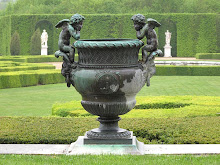Family and friends will recount -- with pleasure I hope -- the hours we've enjoyed together playing the game of Bocce.
Bocce on the beach in southwest Washington, January 2007
So it was easy for Kim and I, at the end of a day-long stroll, to rest our feet awhile and follow the similar game of "Petanque" at the "boulodrome" of the Jardin du Luxembourg.
Pétanque originated in southern France the early 1900s as a form of boules particularly suited to those with arthritis and ailing limbs (other forms of boules, or lawn bowling, involve larger "pitches" with running tosses). With Petanque, the playing area is less precise and smaller. But more importantly, the feet remain stationary and close together, a fact from which the game was originally named. Today, we're in one of some 20 boulodromes in Paris to find out exactly how it's played here.
Firstly, you need to be a member of "L'Association Sportive du Jardin du Luxembourg", unless you're a guest, family member, or playing off-hours. This space is reserved for ASJL members only. Supposedly, one of the benefits of membership is a "boite" (convenient storage for the heavy boules) in the club locker -- which can also display official trophies -- far easier than hauling these steel balls throughout the city.
Lob the boule and hope it's closest to the jack
Not my photo, I got this photo off a website, sorry to the photographer!
THE RULES
Players (referred to as Boulomanes) gather and form teams, typically from 2 to 4 per side. A small wooden ball -- the "jack" -- is tossed across the stone and dirt pitch. In rotation, team members then toss, or lob -- each with individual style -- heavy metal balls towards the jack. Points are scored by the team with a boule, or several boules, closest to the jack. Fans of curling take note: there's no call for sweeping here!
Now, that's a nice toss!
THE HOLD
Each player has two boules with distinctive engravings to mark ownership. Players carry a chamois cloth to occasionally clean their boules. The method of gripping a boule is a matter of preference, and experience, but is often guarded.
THE TOSS
Might you play a lob, in order to send your boule high in the air and stop close to the jack, with minimal role? Or perhaps a slight spin to coax your boule around a protecting opponent's guard? Aggressive players might use "à carreau", a risky shot which attempts to knock away the opponents boule with a smack, while leaving his boule at that exact spot.
THE STRATEGY
The game has a leisurely pace. Male chatter in low tones concerns itself only with boule position, the occasional quip or jab, and frequently stalls. Players openly discuss strategy, but rarely congratulate a fine shot. A perfectly-placed boule is expected of each toss and the only words heard are personal remonstrations like "ah merde!", or "sacre" after a fumbled shot.
SPECTATORS
A well-positioned boulodrome is a fine place to while away a sunny afternoon.
THE PICKUP
To further the arthritis and weak-limbed theme of Petanque, each player carries their own magnetic pick-up device at the end of a long string. Bending over is eliminated, and more individual style is allowed as players swing their magnet in sweeping arches to grab their own boules!
THE DECISION
There's rarely an arguement once the play is over. A fair game of Petanque does not require a measuring tape; the decision of closest boule is left to the team captains and agreed upon amicably.
ON TO ANOTHER GAME
The first team to reach 13 wins the match. There's no rushing here; the play lasts as long as the remaining hours of sunlight. But we have a dinner to prepare back at the apartment so we must grab our bus on the other side of the park. Perhaps we'll return tomorrow.
DM
























No comments:
Post a Comment